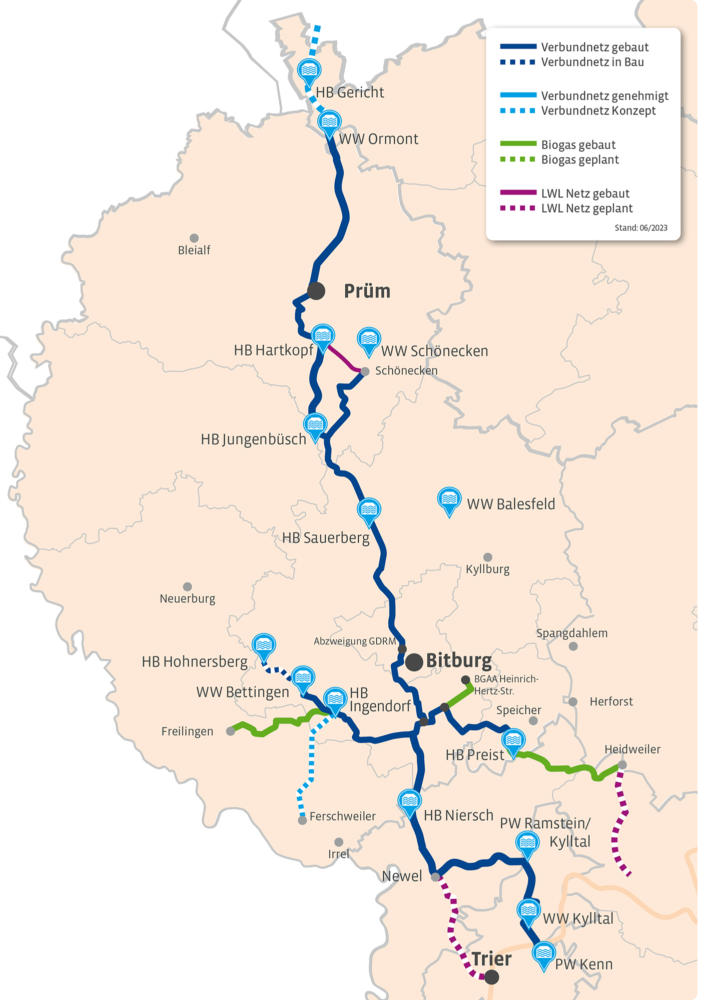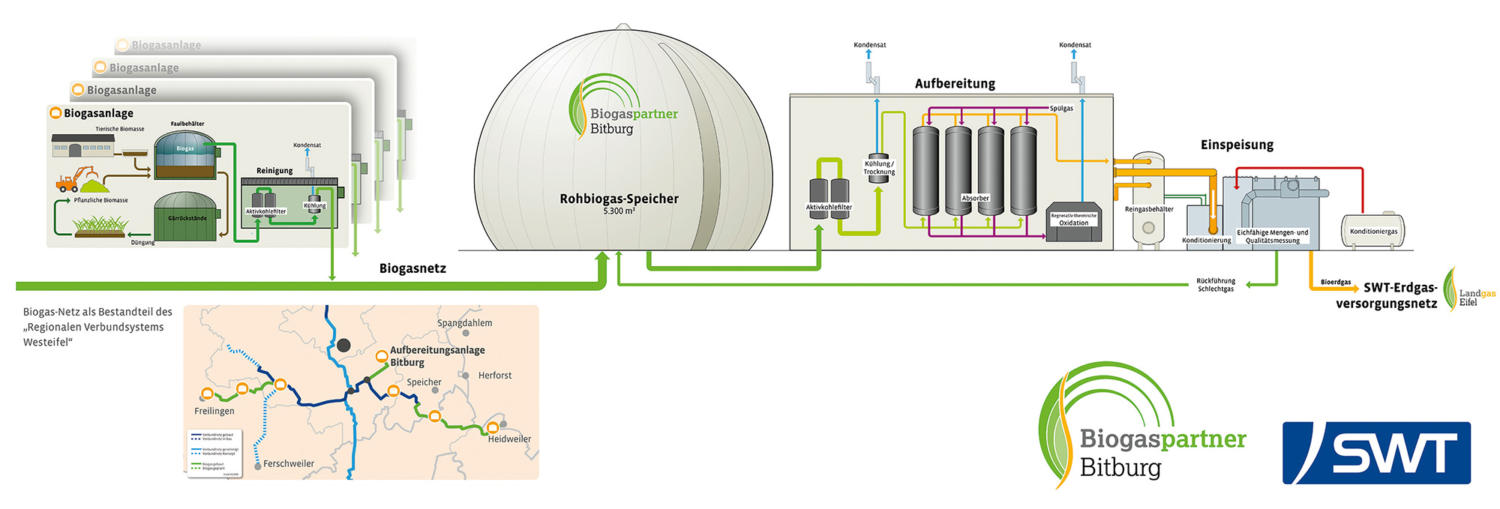Western Eifel regional network system
Exploiting synergies through co-laying
A secure and modern supply of drinking water, energy and telecommunications at favourable conditions, which also makes a contribution to the energy revolution: This is the aim of the “Regional Network System West Eifel” project developed and currently being implemented by Kommunale Netze Eifel AöR (KNE) under the umbrella of Landwerke Eifel AöR (LWE), which was founded together with seven municipal partners. In concrete terms, this means providing a secure supply of underground infrastructure in rural areas by means of a network solution and cross-sector development through the parallel laying of various media. Construction began in April 2018 and, if everything continues according to plan, the main routes and the entire project will be completed by mid-2024.
Cross-sector infrastructure project
LWE is making the Western Eifel region fit for the future with the “Regional Interconnection System Western Eifel”: the core of the project is the construction of an integrated, approximately 80-kilometre- long north-south route, supplemented by an approximately 45-kilometre-long east-west route. In addition to the DN 300 drinking water transport pipeline, various sectors such as natural gas, biogas and fibre optic networks will be laid, depending on the section.
By taking advantage of the topographical conditions, the amount of energy required to supply drinking water will be reduced by around 1 million kWh. By using turbines, LWE will even generate around 0.5 million kWh of electricity per year via the drinking water system. By integrating regional renewable generation plants and intelligent control of relevant consumers, the project also creates important conditions for energy harmonisation in the region and contributes to regional climate protection and structural development.
Project implementation by mid-2024
Following an intensive planning and approval phase, construction of the pipeline began in April 2018 and the numerous individual sections are scheduled to be completed by 2023. In cooperation with SGD Nord, the responsible approval authority, the approval procedures have now been largely completed. In addition, the project has been extended to include an east-west route, taking into account the infrastructure of two other municipalities in the redesign of the water supply and simultaneously linking several biogas plants in the southern project area. The Rhineland-Palatinate Ministry of the Environment is funding the “Regional Interconnected System Western Eifel” with a total of around € 32 million specifically for the expansion of the water supply system. In 2015, the project was honoured as part of the nationwide innovation competition “Landmarks in the Land of Ideas”.
Against the backdrop of demographic change, structurally weak rural areas in particular need to position themselves for the future and create prospects for young people. And this is precisely where the project offers many advantages for the region, such as
- From the Western Eifel to Trier, some 250,000 people will benefit from the large-scale project from affordable energy and water supply.
- The fibre optic network laid as part of the project creates the conditions for a fast internet connection for business customers and potentially for up to 27,000 households.
- The critical “drinking water” infrastructure will be controlled via the company’s own fibre optic cable.
Concrete benefits of the joint project
Drinking water supply example
The planned interconnected drinking water system will link high-capacity abstraction and treatment plants between the Oleftal reservoir in the northern Eifel and the Riveristal reservoir in the Hunsrück. The new pipeline will ensure maximum security of supply for all project partners and will also allow the supply to be used beyond the boundaries of the joint municipality. In concrete terms, this means that the municipal utilities will be able to dispense with costly and difficultto- protect smaller intake systems and use larger intake systems with well-designated drinking water protection zones. In addition to the quantity, the quality of the drinking water also plays a decisive role in the project. By making targeted use of the modern treatment plants of the project partners, the high requirements of the Drinking Water Ordinance can be ensured in the long term.
Even though the construction work for the regional network in the West Eifel region has not yet been completed, the project has already proved its worth. the project has already proved its worth: In addition to the new pipelines, the network will connect various production facilities in the future and open up new opportunities for the participating utilities. For example, after the devastating flood in July 2021, the communities of Nattenheim and Fliessem, which were cut off from the drinking water network, were quickly supplied from another waterworks. Without the interconnected network, the rapid restoration of the drinking water supply would not have been possible.
Hydrogeological groundwater model
In order to secure groundwater resources in the long term, the municipal water utilities, under the leadership of LWE, developed a hydrogeological groundwater model for the Bitburg-Trierer Mulde and coordinated it with SGD Nord and the involved state offices for the environment, mining and geology. The investigations confirm that there is a very good groundwater supply with high quality raw water at a central location. In order to increase the treatment capacity at this site, a significant expansion of the waterworks is now planned: LWE is investing € 14 million in the expansion of the site by 2024. In addition to new treatment filters, a special softening plant is also planned to bring the comparatively hard deep groundwater from the artesian well into line with the water from the other extraction areas.
Efficiency through reversal of flow
At present, drinking water is pumped into elevated tanks within each project partner’s service area in order to maintain sufficient network pressure. With the planned interconnected network, the additional volume of just 1 million cubic metres of water per year from the Oleftalsperre in North Rhine-Westphalia – out of a total discharge of 21 million m³ per year for the entire project area – is sufficient to save around 1 million kWh of pumping energy per year.
The background
If you look at the elevation profile in the project area between Trier and the highest point in the north of the project area, you can simply say that the direction of the water flow is reversed. Instead of pumping drinking water from south to north, the project uses the natural slope of the terrain, a gradient of around 450 m, to allow drinking water to flow from north to south.
Power generation in the water network
The elevation profile of the route, with a difference of around 450 metres between the border of North Rhine-Westphalia and the southern supply area on the Moselle, also allows the use of turbines or reverse flow pumps in the drinking water network to generate electricity. According to current plans, four turbines or reverse-flow pumps will be installed at three locations. This will enable LWE to generate more than 500,000 kWh of electricity per year in the drinking water network.
Intelligent control
The project also involves using the kinetic energy of the existing infrastructure to store energy. What does this mean in practice? Existing elevated tanks will be used to balance the region’s renewable energy production. Many of the more than one hundred drinking water reservoirs in the region (with a total storage capacity of around 110,000 m³) are currently operated purely according to water demand, i.e. they are filled and emptied. The aim of the project is to use pumping energy to fill the reservoirs when surplus electricity from regional renewable energy sources is available. In addition to security of supply aspects, the project also takes into account the current situation in the electricity generation market.
Example of prospects for regional biomethane
There are currently 48 biogas plants in the entire project area. By way of comparison, these biogas plants together produce twice as much energy as the town of Bitburg, including its large brewery, needs. Due to legislation (EEG), the biogas is not converted into electricity in line with demand, but in a decentralised manner around the clock. The resulting heat is also not being used optimally. As part of the project, seven plants have already been economically connected to their own biogas network and controlled via their own fibre-optic network. The biogas is processed centrally at the Bitburg airfield and fed into the natural gas network. The processing plant of the newly founded Biogaspartner Bitburg GmbH was commissioned in summer 2020 (Fig. 1).
There are currently two natural gas concessionaires in the project area. There is no connection between their networks. As part of the development of the West Eifel Interconnected System, these natural gas networks are to be linked. By connecting the upstream high-pressure gas networks, the project will create a redundant supply situation, which will also have a positive effect on security of supply. The high-pressure gas network will also provide a storage option in the summer to make the processed biomethane available for the heating period. The processed biomethane will then be used in gas-fired combined heat and power plants using energy- efficient cogeneration. The electricity generated will be used to compensate for the lack of PV generation. In this way, the project contributes to the overarching goal of climate change mitigation by utilising the biogas resources
Highly innovative rural areas
The network is a unique project in Germany (planned total costs: around € 90 million) under the leadership of LWE, a consortium of seven municipal project partners: Kommunale Netze Eifel AöR, Eifelkreis Bitburg-Prüm – Wasserversorgung Eifelkreis Bitburg- Prüm, Zweckverband Wasserwerk Trier-Land, Zweckverband Wasserwerk Kylltal, Stadt Bitburg – Eigenbetrieb Stadtwerke Bitburg, Südeifelwerke Irrel AöR and Verbandsgemeinde Speicher. “Our goal is the innovative further development of the infrastructure in our rural area through an integrated energy and water supply,” says the LWE board.
By September 2022, around 90.0 km of interconnected grid routes have been laid. The lengths of the individual supply sectors are 115.3 km for drinking water, 133.7 km for fibre optic cables, 48.0 km for biogas and 30.3 km for gas. Construction has so far been on schedule and within budget (Fig. 2).
Author:
Helfried Welsch


